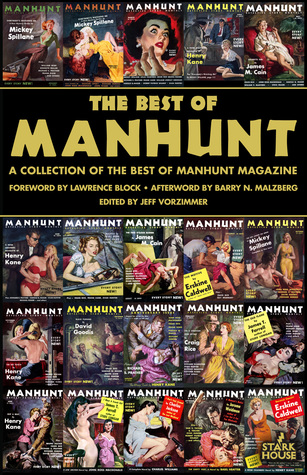Title: The Best Of Manhunt
Rating: 4 Stars
Manhunt was a pulp magazine started in 1953 that ran for about fifteen years. It positioned itself as a successor to the Black Mask magazine. Both specialized in hard-boiled crime noir fiction. The anthology that I read was probably about fifty short stories that appeared in Manhunt.
Usually, when I read a short story collection this large, the stories all kind of blend together. This did happen here, but I was impressed at the variety of stories that fell under the auspices of noir. I came in expecting that most of the stories would be the typical variety of the hard bitten detective being brought into a case by a femme fatale. After getting knocked on his head a couple of times, throwing down some whiskey, and shooting dead some bad guys, he would inevitably wrap up the case.
There were definitely cases like this here, but they were the minority.
There were stories involving gang members. In On The Sidewalk Bleeding, there was a teenager wearing a Royal gang jacket dying in an alley after being stabbed in a gang fight. We listen to his thoughts as he futilely tries to attract attention and confronts his fears of dying and death. In Pistol, a young new gang member, eager to prove his worth and masculinity to the other gang members, desperately tries to acquire a gun. In The Last Spin, two young members of competing gangs are forced to play Russian roulette. In so doing, they discover that they have a lot in common and establish a friendship, even as they keep adding bullets to the gun.
Many of the stories feature unexpected twists. Picture some bizarre combination of O Henry and Rod Serling. In The Quiet Room, a corrupt veteran detective makes a fortune by forcing underage women into prostitution and then blackmailing their customers. All goes well until his young daughter becomes ensnared. In Pigeon In An Iron Lung, a rich polio victim discovers that his wife is about to murder him. What can a helpless man in an iron lung do? You might be surprised.
There’s a number that are just dark and twisted. In The Day That It Began Again, a man decides that the only way to save his serial killing best friend is to become a serial killer himself. In Rat Hater, a man waits nineteen years to gruesomely avenge the gangland murder of his sister.
Femme fatales are a trope in crime noir. In a couple of stories here, the women move beyond the trope into the grotesque. In Hit And Run, a private detective witnesses a wealthy woman run over a man and flee. He tracks the woman down hoping to blackmail her. Instead, the woman, discovering that she has a decided taste for murder, pulls the detective into her web, and he has to take drastic actions to escape. Similarly, in Somebody’s Going To Die tonight, a man is being blackmailed by his partner. His wife convinces him to murder his partner. She enjoys it so much that the man comes home one day to discover her grooming another possible victim. He’s left with a choice. Who will be the next victim?
I wonder if the stories of these staid conventional women suddenly developing homicidal tendencies somehow speaks to the time in which they were written. In the early to mid 1950s, men have come home from war. Women who had experienced increased freedom during the war years were now supposed to be firmly ensconced in traditional family life and loving it. In this, what to all appearances, seems to be a stable society, could there have been lurking repressed frustrations?
Similarly, during post World War II, men were finding themselves in a new place. Yanked from the harsh realities of mortal combat and forced to find their way in the rigid, repressed society of the Eisenhower years (the film Best Years of Our Lives is still the best representation of this), could these stories have been an outlet?
Looking on the 1950s from the point of view of the 2020s, even though I know better, I still think of them as being Leave it to Beaver and Happy Days. Reading these stories with their gothic plots, sexual freedom, extreme violence, and twisted morality, paints a very different portrait of the underbelly of the 1950s.
One final note. I’m now convinced that the ultimate noir author is David Goodis. Most famous for Shoot the Piano Player and Dark Passage, he is the master of the doomed protagonist. His stories are the darkest of noir. There really is no hope. The best case for the protagonist is a death with some kind of dignity. Here his work is well represented in Professional Man. A hit man moonlights as an elevator operator to cover his real job. He has a girlfriend. That is, until his crime boss orders that the hit man kills his girlfriend. He has a decision to make. Does he kill his girlfriend? If he does, how can he live with himself?
It is a grim story with a dark ending, as only Goodis can write it. As sometimes happens with him, if you squint carefully, you might see a very tiny sliver of light.
Noir at its best.
